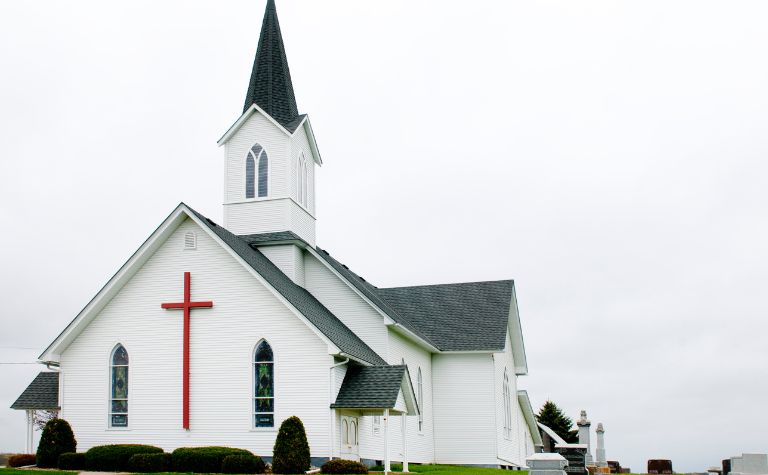Christians have celebrated Lent in some way since the church started because preparing to celebrate the resurrection of Jesus Christ has always been considered important. Many people associate Lent with the Roman Catholic Church but are unsure if Protestants observe the 40-day period as well.
Many Protestant traditions celebrate Lent, though their observance is not the same as Catholicism. The Anglican and Lutheran traditions have historically celebrated Lent. Some Presbyterian, Baptist, and non-denominational churches also celebrate it. Some Methodists and Assemblies of God celebrate Lent too.
What is Lent? How is it related to Ash Wednesday and Easter? Why does some people’s observance of Lent include having cross-shaped ashes on their foreheads? Keep reading to learn more.
Also, see Roman Catholic vs. Protestant vs. Eastern Orthodox: What’s the Difference? to learn more.

What Does Lent Mean?
The word Lent comes from the word Lenten, which has roots in Old English. “Lenten” referred to the lengthening of daylight hours in the Spring. The 40 days of Lent and the celebration of Easter that occurs at the conclusion of it occurs every year in the Spring. (Also see Why Don’t Protestants Use Crucifixes?)
What is the purpose of Lent?
The purpose of Lent has changed over the centuries, though the commonality through the millenniums is that it is intended to prepare people to celebrate the resurrection of Jesus Christ. (Also, see Why Don’t Protestants Make the Sign of the Cross?)
Originally, Lent only lasted for one week, and its main purpose was to prepare people for baptism during the Easter liturgy.
When did Lent become a 40-day period?
In the 7th century, the church established the 40-day period of Lent, which was comprised of penitence and preparation, yet there is evidence that some believers had been having similar observances centuries earlier.
The Oxford Dictionary of the Christian Church explains, “In the first three centuries, the period of fasting in preparation for Easter did not, as a rule, exceed two or three days, as is evident from a statement of Irenaeus recorded by Eusebius (Hist. Eccl. 5. 24. 12). The first mention of a period of 40 days…, probably of Lent, occurs in the Canons of Nicaea (ad 325; can. 5).”
It continues, “The custom may have originated in the prescribed fast of candidates for baptism, and the number 40 was evidently suggested by the 40 days’ fasts of Moses, Elijah, and esp. the Lord Himself, though till a much later date the period was reckoned differently in the different Churches.” [1]
Also, see Do All Denominations Observe Lent? to learn more.

Why Is Lent 40 Days Long?
In the 7th century, the church established that Lent would be 40 days long. The number 40 comes from the number of days that Christ spent in the wilderness.
Matthew 4:1-2 read, “Then Jesus was led by the Spirit into the wilderness to be tempted by the devil. After fasting forty days and forty nights, he was hungry.” (Also see Why Did Protestants Leave the Catholic Church?)
What is penitence?
Penitence comes from a Latin word meaning “to repent,” as in to regret or be sorry for something. In the Protestant tradition, pertinence and repentance are used synonymously.
The Catholic sacrament of “penance” has a different meaning. The season of Lent is partly for people to turn from sin and reset their pursuit of holiness. (Also, see Protestant vs. Reformed: What’s the Difference?)
Do Protestants fast during Lent?
Some Protestants fast during Lent. The tradition of fasting during Lent likely comes from Christ’s abstaining from food in the wilderness (Matt. 4:2). Traditionally, Christians fast on Fridays during Lent.
Some believers abstain from all food, but others abstain from certain foods. Like Catholicism, people with special physical needs, like children and the elderly, are not expected to fast. (Also see Why Don’t Protestant Churches Have Nuns?)
Do Protestants have to pray in a certain way during Lent?
Protestants are not required to say certain prayers word-for-word, but denominations and churches sometimes guide their members.
For example, one Anglican tradition encourages its members to say this prayer on the first Sunday of Lent, “Almighty God, whose blessed Son was led by the Spirit to be tempted by Satan: Come quickly to help us who are assaulted by many temptations, and, as you know the weaknesses of each of us, let each one find you mighty to save; through Jesus Christ your Son our Lord, who lives and reigns with you and the Holy Spirit, one God, now and for ever. Amen.”
Also, see Do Lutherans Observe Lent? to learn more.

What Is Ash Wednesday?
Ash Wednesday is the first day of Lent. Many people associate Ash Wednesday with Christians getting ashes smeared on their foreheads in the shape of a cross. (Also, see Protestant vs. Anglican: What’s the Difference?)
This tradition comes from the 10th century. It is a public demonstration of penance or repentance. Over time, anyone who attended an Ash Wednesday service had ashes smeared on their foreheads.
Genesis 3:19 is often cited to explain the symbolism of the ashes, By the sweat of your brow you will eat your food until you return to the ground, since from it you were taken; for dust you are and to dust you will return.”
Ezekiel 9:3-4 is cited as an example of repentant people receiving a mark on their forehead, “Now the glory of the God of Israel went up from above the cherubim, where it had been, and moved to the threshold of the temple. Then the Lord called to the man clothed in linen who had the writing kit at his side and said to him, ‘Go throughout the city of Jerusalem and put a mark on the foreheads of those who grieve and lament over all the detestable things that are done in it.'”
Do Protestants observe Ash Wednesday?
Some Protestant traditions, like certain Anglican and Lutheran denominations, observe Ash Wednesday with a service that includes smearing ashes on the foreheads of those in attendance. (Also, see Why Do Protestants Use Grape Juice At Communion?)
Other Protestant denominations and churches have an Ash Wednesday service that does not include using ashes.
Some Protestants believe that a public sign of repentance violates Christ’s instructions in Matthew 16:16-18, “When you fast, do not look somber as the hypocrites do, for they disfigure their faces to show others they are fasting. Truly I tell you, they have received their reward in full. But when you fast, put oil on your head and wash your face, so that it will not be obvious to others that you are fasting, but only to your Father, who is unseen; and your Father, who sees what is done in secret, will reward you.”
Other Protestants do not have an Ash Wednesday service yet still begin their observance of the Lenten season on that day.
Fasting from certain foods, other forms of sacrifice, and increased Bible reading and prayer are practices that mark the beginning of Lent for Protestants who observe the season. (Also, see Protestant vs. Lutheran: What’s the Difference?)
Please see the related articles below.
References:
[1] Source
[2] Source
[3] Source
Related Questions
Catholic vs. Protestant vs. Orthodox: What's the Difference?
Roman Catholicism, Protestant Christianity, and the Eastern Orthodox Church are the three historical branches of the Christian religion. Each tradition traces its doctrines and practices to the New...
Protestantism and Anglicanism are branches of the Christian faith that have roots in Europe. Protestantism and Anglicanism have similarities and differences with each other as well as other...
